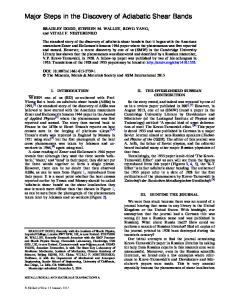Numerical modeling of the propagation of an adiabatic shear band
- PDF / 911,712 Bytes
- 8 Pages / 594 x 774 pts Page_size
- 40 Downloads / 344 Views
I.
INTRODUCTION
AN adiabatic shear band is a strain localization phenomenon that occurs when the rate of softening of the material due to temperature increase is greater than the rate of work hardening due to plastic deformation. Adiabatic shear bands have been characterized in numerous metallurgical investigations, and the reviews by Rogers, ~ Bedford et al., 2 and Olson et al. 3 attest to this. The mechanical modeling of these bands has also been conducted, with a number of different approaches. 4-16 The work is presented by Mescall and Weiss. 17The destabilizing effect of thermal softening, reducing the slope of the stress-strain curve in nearly adiabatic deformation, was first recognized by Zener and Hollomon. 9 The nucleation of shear bands was first correlated with the shear strain at which the slope of the adiabatic stress-strain curve is zero by Recht, 4 and this method has been developed further by other researchers. 4'1~ An elementary linear perturbation analysis of plastic instability due to thermal softening for the nucleation of a shear band was presented by Clifton et al.,~2 and this method has been applied by other researchers. 8'~3-~5 The formation of the shear band was analyzed numerically by Olson et al. 3 using the HEMP code (finite difference formulation) and by Lindholm et al., t6 using the EPIC code (finite element method); these codes deal with the combined thermalmechanical problem. The former analyzed the formation of a shear band produced by the simple shearing in a twodimensional rectangular body, and the latter analyzed it in a thin-walled tubular specimen subjected to pure torsional loading. A comprehensive development program of a computational model for shear bands has been carried out at SRI-International by Seaman, Curran, Shockey, Erlich, and co- workers. 6.18-20 SHINHOU KURIYAMA is with Institute of Physical and Chemical Research, Wako, Saitama 351-01, Japan. MARC ANDRI~ MEYERS is with Center for Explosives Technology Research, New Mexico Institute of Mining and Technology, Socorro, NM. Manuscript submitted June 3, 1985. METALLURGICAL TRANSACTIONS A
In all of these studies, the shear band was treated as an interface (or a region with discrete thickness) of discontinuity.* The present work focuses on the tip of the shear *Formulations incorporating both heat transfer and the effect of strain rate on the flow stress have been developed by M. Wada, T. Nakamura, and K. Kinoshita (Phil. Mag. A, 1978, vol. 38, p. 167), and the effect of strain rate on the flow stress has been developed by M. Wada, T. Nakamura, and K. Kinoshita (Phil. Mag. A, 1978, vol. 38, p. 167) and A.M. Merzer (J. Mech. Phys. Sol., 1982, vol. 30, p. 323). G. R. Johnson (J. Eng. Mat. and Techn., 1981, vol. 103, p. 201) compared experimental results with an analysis using the finite element method incorporating strain rate, temperature, and heat transfer effects. However, none of the above analyses addressed the tip of the shear band.
band, and assumes that the critical phenomena dictating the propagation or arrest
Data Loading...











